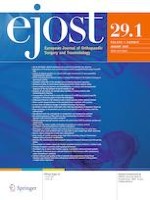Erschienen in:

18.06.2018 | Original Article • SPINE - IMAGING
Impact of patient position on coronal Cobb angle measurement in non-ambulatory myelodysplastic patients
verfasst von:
Norman Ramirez, Jorge Padilla, Sigfredo Villarin, Francisco Irizarry, Ivan Iriarte, Jeffrey Sawyer
Erschienen in:
European Journal of Orthopaedic Surgery & Traumatology
|
Ausgabe 1/2019
Einloggen, um Zugang zu erhalten
Abstract
Objective
The purpose of this study was to assess the impact of patient position on the magnitude of the coronal Cobb angle measurements in relation to the change of position using plain radiograph on non-ambulatory children with myelodysplasia.
Summary of background data
Whole-spine radiographs with the patient sitting generally are preferred for the diagnosis and monitoring of progression of scoliosis in neuromuscular patients. Supine, supine traction, and sitting push-up positions have been used as substitutes, although there is no general consensus validating if these positions correlate with the sitting position. The magnitude of the Cobb angles in neuromuscular scoliosis may vary greatly depending on the position of the patient.
Methods
Radiographs of 39 myelodysplastic, non-ambulatory children were evaluated to assess the impact of change in positions (unsupported sitting, sitting push-up, supine, and supine traction) on coronal Cobb angle measurement using plain whole-spine radiographs.
Results
The mean difference in thoracic Cobb angle measurements between sitting and all other positions ranged from 6° to 12°. At the lumbar level, the Cobb angles ranged from 12° to 16°.
Conclusions
Statistically significant differences in the Cobb angle measurements were identified between plain radiographs of the whole spine with the patient in the unsupported sitting position compared to sitting push-up, supine, and supine traction positions. The data support that the magnitude of the Cobb angles in neuromuscular scoliosis varies greatly depending on the position of the patient.











